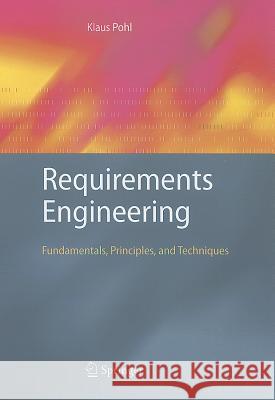Requirements Engineering: Fundamentals, Principles, and Techniques » książka



Requirements Engineering: Fundamentals, Principles, and Techniques
ISBN-13: 9783642125775 / Angielski / Twarda / 2010 / 813 str.
Requirements Engineering: Fundamentals, Principles, and Techniques
ISBN-13: 9783642125775 / Angielski / Twarda / 2010 / 813 str.
(netto: 477,32 VAT: 5%)
Najniższa cena z 30 dni: 497,71 zł
ok. 20 dni roboczych.
Darmowa dostawa!
This textbook provides a comprehensive and well-structured introduction to the fundamentals, principles, and techniques of requirements engineering. The book includes numerous real-world examples to illustrate all aspects of requirements engineering.
Glosariusz/słownik
Wydanie ilustrowane
Podręcznik
From the reviews:
"[...] Pohl succeeds in providing "a comprehensive, well-structured, and easy-to-read ... compendium" on the field of requirements engineering where such did not exist previously. It serves as an excellent reference volume [...]. The layout, visuals, and organization of the book are exceptional. [...] Students, practitioners, and researchers with an interest in requirements engineering for software and systems engineering should consider adding this unique book to their library." ACM Computing Reviews, Michael G. Murphy, Southern Polytechnic State University, Marietta, GA, USA, January 2011
"800-page volume divided into eight parts and 38 chapters. Pohl went to great lengths in organizing the book, and has been successful in providing a clean, comprehensive, and well-structured work. ... Each part provides collections of basic and advanced reading lists for the individual chapters. The book concludes with a very helpful glossary of terms, a comprehensive collection of references, and a well-organized index. Summing Up: Highly recommended. Upper-division undergraduate through professional collections." J. Beidler, Choice, Vol. 48 (6), February 2011
Part I Fundamentals and Framework.- 1 Motivation - 2 Requirements - 3 Towards Continuous Requirements Engineering - 4 TheRequirements Engineering Framework.- Part II System Context.- 5 Context and Context Separation - 6 Context Structuring Scheme.- Part III Requirements Artefacts.- Part III.a Goals.- 7 Fundamentals - 8 Documentation of Goals.- Part III.b Scenarios.- 9 Fundamentals - 10 Types of Scenarios - 11 Documentation of Scenarios - 12 Usage of Goals and Scenarios.- Part III.c Solution-Oriented Requirements.- 13 Traditional Perspectives of Requirements - 14 Object-Oriented Models.- Part IV Core Activities.- Part IV.a Documentation.- 15 Fundamentals of Documentation - 16 Documentation in Natural Language - 17 Structuring Textual Requirements - 18 Fundamentals of Conceptual Modelling - 19 Model-Based and Textual Requirements.- Part IV.b Elicitation.- 20 Fundamentals of Elicitation - 21 Elicitation Techniques - 22 Assistance Techniques for Elicitation.- Part IV.c Negotiation.- 23 Fundamentals of Negotiation - 24 Conflict Management - 25 Negotiation Techniques.- Part V Validation.- 26 Fundamentals of Validation - 27 Validation Techniques - 28 Assistance Techniques for Validation.- Part VI Management.- 29 Three Management Activities - 30 Traceability of Requirements - 31 Prioritisation of Requirements - 32 Change Management for Requirements.- Part VII The Goal- and Scenario-based Requirements Engineering Method COSMOD-RE.- 33 The COSMOD-RE Method - 34 Application of the COSMOD-RE Method: A Driver Assistance System.- Part VIII Requirements Engineering for Software Product Lines.- 35 Fundamentals of Software Product Line Engineering - 36 Managing Product Line Variability - 37 Domain Requirements Engineering - 38 Application Requirements Engineering.- Part IX Relations to Design and Testing.- 39 Intertwining of Requirements Engineering and Architecture - 40 Requirements-based Testing.
Dr. Klaus Pohl is full professor for software systems engineering and director of the Institute for Computer Science and Business Information Systems at the University of Essen, Germany. He holds a degree in computer science (FH Karlsruhe, Germany) and a degree in information systems (Univ. Konstanz, Germany). Klaus Pohl received his PhD and his habilitation in Computer Science from the Technical University of Aachen, Germany. His current research interest include software product lines, requirements management and scenario-based test case derivation. Current research projects include the European ITEA initiative in software product lines (the CAFÉ project) and various industrial uptake projects with leading Germany companies. Klaus Pohl is (co-)author of over 90 referred publications in the area of requirements and software engineering. He as published a book on Process-Centred Requirments Engineering (RSP/Wiley) and is (co-editor) of more than 15 conference and workshop proceedings. Moreover, he is/was co-editor of several special issues of well-established journals, including 'Introduction of Software Product Lines', IEEE Software, 2002. He is a member of the IFIP working-group 2.9 on software requirements engineering, member of the steering committee of the IEEE Intl. Requirements Engineering Conference (RE), member of the editorial board of the Requirements Engineering Journal and founder and member of the advisory board of the Requirements Engineering: Foundation for Software Quality (REFSQ) workshop series. He is/was program chair of various conferences and workshops including the IEEE Joint Intl. Requirements Engineering Conference (RE 02).
Requirements engineering is the process of eliciting individual stakeholder requirements and needs and developing them into detailed, agreed requirements documented and specified in such a way that they can serve as the basis for all other system development activities. In this textbook, Klaus Pohl provides a comprehensive and well-structured introduction to the fundamentals, principles, and techniques of requirements engineering. He presents approved techniques for eliciting, negotiating and documenting as well as validating, and managing requirements for software-intensive systems. The various aspects of the process and the techniques are illustrated using numerous examples based on his extensive teaching experience and his work in industrial collaborations. His presentation aims at professionals, students, and lecturers in systems and software engineering or business applications development. Professionals such as project managers, software architects, systems analysts, and software engineers will benefit in their daily work from the didactically well-presented combination of validated procedures and industrial experience. Students and lecturers will appreciate the comprehensive description of sound fundamentals, principles, and techniques, which is completed by a huge commented list of references for further reading. Lecturers will find additional teaching material on the book’s website, www.requirements-book.com.
1997-2025 DolnySlask.com Agencja Internetowa
KrainaKsiazek.PL - Księgarnia Internetowa









